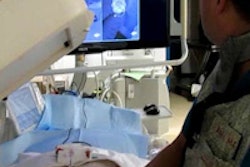
In patients receiving drug-eluting stents for long coronary lesions, guidance using intravascular ultrasound (IVUS) yields much better outcomes than implantation guided by angiography, researchers from South Korea reported in the Journal of the American Medical Association.
The trial, led by Dr. Sung-Jin Hong of Sanggye Paik Hospital in Seoul, involved 1,400 patients at 20 centers in South Korea and was conducted over nearly four years. The group found that patients who received IVUS guidance to implant drug-eluting stents for long coronary lesions had nearly half the rate of major adverse cardiac events compared to those who had angiography guidance.
"These differences were primarily due to lower risk of target lesion revascularization," the authors wrote.
Challenging lesions
Drug-eluting stents have helped to significantly reduce in-stent restenosis and repeat revascularization; however, percutaneous coronary intervention (PCI) of diffuse long coronary lesions remains difficult, as these have higher rates of in-stent restenosis and stent thrombosis than lesions that are shorter in length, according to the authors. Implantation of drug-eluting stents under IVUS guidance has been shown in four meta-analyses to be associated with reduced major adverse cardiac events, but the procedure's effect on clinical outcomes remains uncertain due to the limited number of randomized trials with sufficient statistical power.
What's more, most of the studies that have assessed IVUS for guiding drug-eluting stent implants relied on first-generation stents; second-generation stents are now exclusively used for PCI in current clinical practice, according to the authors. As a result, the group developed the randomized, multicenter Impact of Intravascular Ultrasound Guidance on Outcomes of Xience Prime Stents in Long Lesions (IVUS-XPL) trial (JAMA, November 10, 2015).
Working under the hypothesis that IVUS-guided stent implants would be superior to angiography-guided placement in patients with long coronary lesions, the researchers enrolled 1,400 patients at 20 centers in South Korea between October 2010 and July 2014. Patients with typical chest pain or evidence of myocardial ischemia were eligible for the study if they were indicated -- based on angiographic assessment -- to receive an everolimus-eluting coronary stent (Xience Prime, Abbott Vascular) for long coronary lesions (implanted stent ≥ 28 mm in length).
Patients were then randomly assigned to receive either IVUS-guided or angiography-guided stent implantation immediately after receiving a pre-PCI angiogram. For the 700 patients in the angiography-guided stent group, visual estimation was used to choose the stent size and length. If an optimal result -- defined as angiographic residual diameter stenosis of less than 30% by visual estimation and the absence of angiographically detected dissection -- was not achieved, adjunct high-pressure dilation was performed, according to the researchers.
As for the 700 patients in the IVUS group, online IVUS measurements were used to select stent size and length; adjunct high-pressure dilation was performed at the discretion of the physicians based on IVUS findings. Physicians could perform IVUS at any step of PCI, but they also had to perform an IVUS exam after the PCI was completed.
The researchers then tracked the patients for major cardiac adverse events such as cardiac death, target lesion-related myocardial infarction, or ischemia-driven target lesion revascularization. Following their stent implantation, patients received postprocedural clinical follow-up in the hospital and then one, three, six, and 12 months later in a physician office visit. Seventy-seven patients either withdrew consent to participate in the study or were lost to follow-up, leaving a final total study group of 1,323 patients.
Fewer adverse events
At one year, 19 patients (2.9%) in the group that received IVUS guidance had experienced a major cardiac adverse event, compared with 39 (5.8%) in the group receiving angiography guidance. The 48% relative reduction in risk was statistically significant (p = 0.007).
"These differences were mainly driven by the reduction of [target lesion revascularization] in the IVUS-guided group," the authors wrote.
Specifically, ischemia-driven target lesion revascularization was required in 17 patients in the IVUS-guided stent group, compared with 33 patients in the group that received angiography guidance. That difference was also statistically significant (p = 0.02).
Three patients (0.4%) in the IVUS-guided stent group experienced cardiac death, compared with five (0.7%) in the angiography-guided stent group. One patient in the angiography-guided stent group had a target lesion-related myocardial infarction. Neither of these differences reached statistical significance, however.
The researchers acknowledged a few limitations to their study, including the current lack of established defined criteria for optimizing drug-eluting stents to prove favorable clinical outcomes and the possibility that the angiography-guided procedure is not completely exclusive of the IVUS-guided method.
"The physicians used in this study were proficient in both approaches, and their expert knowledge of IVUS may have unintentionally biased their approach when using angiography guidance," they wrote.
In addition, the study did not account for cardiac adverse events after one year of follow-up, and it could not blind the patients or the treating physicians due to the different procedures required for each guidance method.
"However, we minimized the risk for any potential bias by using an end-point analysis with precisely defined criteria, using core laboratories, blinding the adjudication by event adjudication committee members, and analyzing the data using intention-to-treat measures," they wrote.
The authors also noted that the overall major adverse event rate was lower than they anticipated.
They concluded that "among patients requiring long coronary stent implantation, the use of IVUS-guided everolimus-eluting stent implantation, compared with angiography-guided stent implantation, resulted in a significantly lower rate of the composite of major adverse cardiac events at one year."




















